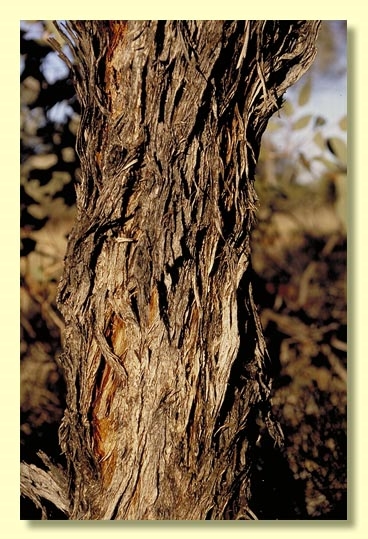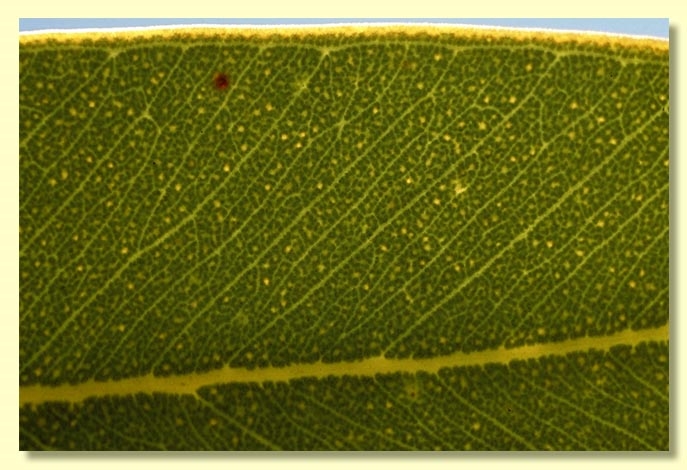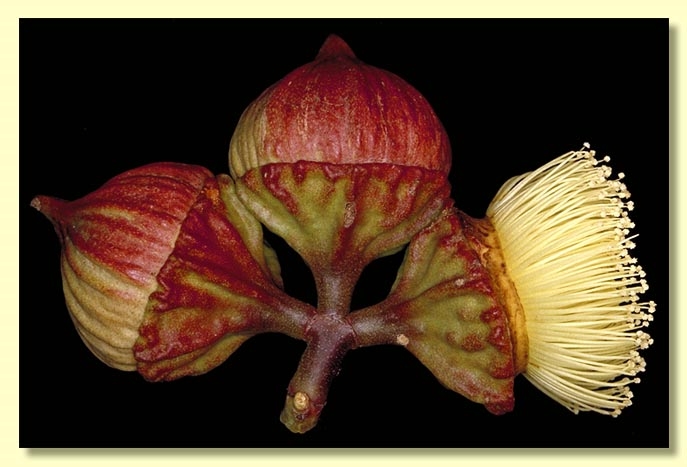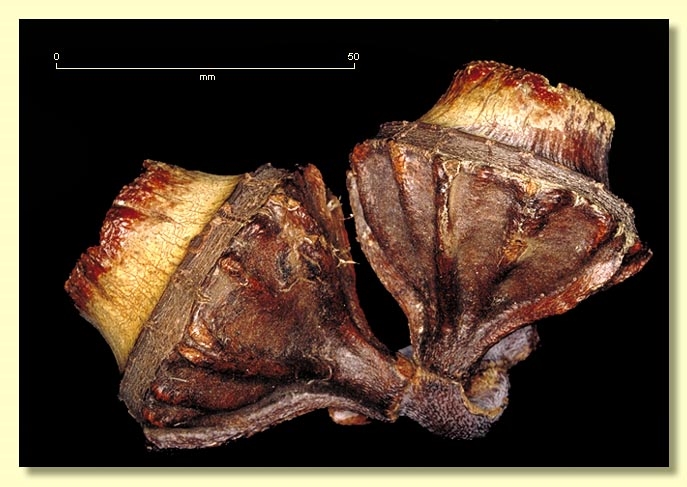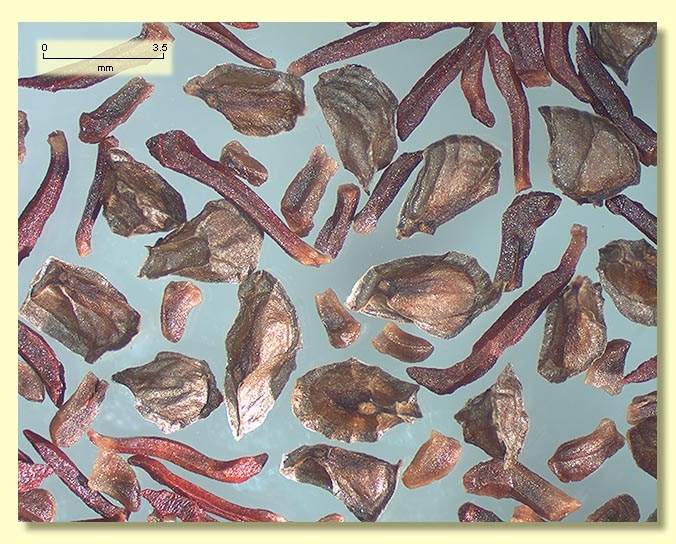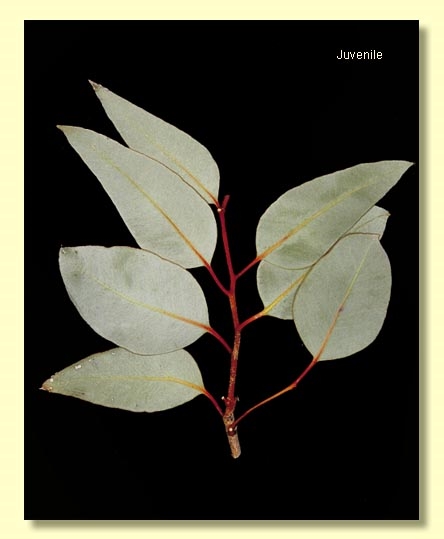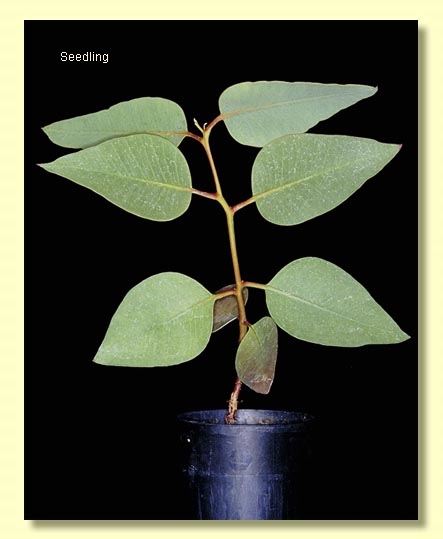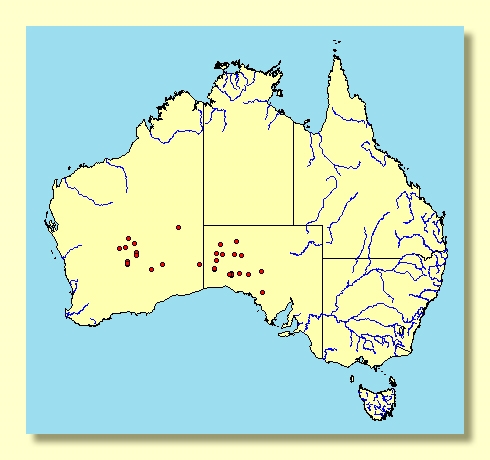Euclid - Online edition
Eucalyptus youngiana
Eucalyptus | Symphyomyrtus | Bisectae | Destitutae | Curviptera | Xylocarpae
Eucalyptus pyriformis subsp. youngiana (F.Muell.) Boomsma, Trans. Roy. Soc. S. Australia 93: 161 (1969). T: Queen Victoria Spring, W.A., 1875, J.Young s.n.; syn: MEL; 'Fowlers Bay' [actually at Ooldea], S.A., Mar. 1875, Police Trooper Richards s.n.; syn: MEL.
Bark rough over part or all of trunk, grey, fibrous or shedding imperfectly in broad strips, smooth above, or on smaller stems smooth throughout, whitish grey over yellowish or salmon pink.
Branchlets glaucous or non-glaucous; lacking oil glands in the pith.
Juvenile growth (coppice or field seedlings to 50 cm): stems rounded in cross-section; juvenile leaves alternate, always petiolate, ovate-lanceolate, 7–16 cm long, 2.5–4.5 cm wide, base tapering to petiole or rounded, grey-green to blue-grey.
Adult leaves alternate, petioles 1.5–3.2 cm long; blade usually lanceolate, 8.5–17 cm long, 1.5–3.7 cm wide, base tapering to petiole, concolorous, dull, blue-green, side-veins greater than 45° to midrib, densely reticulate, intramarginal vein close to margin, oil glands intersectional.
Inflorescence axillary unbranched, peduncles 1–2.5 cm long, stout, terete to angular, usually down-turned; buds 3, pedicellate, pedicels 0.5–1.5 cm long. Mature buds ovoid (4.5–6 cm long, 3–4.5 cm wide), coarsely ridged, glaucous or greeny-yellow, scar present, operculum beaked (2.8–4.2 cm long), stamens erect to oblique, arranged in 6 whorls, anthers oblong-globloid, versatile, more or less basifixed, dehiscing by lateral slits, style long, stigma blunt, locules 4 to 6, the placentae each with 10 or 12 vertical ovule rows. Flowers red, pink or bright yellow.
Fruit spreading to rigidly down-turned, pedicellate to rarely sessile, pedicels (0)0.5–1.3 cm long, shortly and broadly obconical, 1.5–3 cm long, 3.3–6(7.2) cm wide, coarsely ridged longitudinally, disc raised, concave and often paler than the rest of the fruit, valves 4 to 6, at rim level.
Seeds brown-grey, 2.5–4 mm long, obliquely pyramidal, dorsal surface smooth to shallowly reticulate, sides prominently ribbed, well-developed marginal flange present, hilum terminal.
Cultivated seedlings (measured at ca node 10): cotyledons Y-shaped (bisected); stems rounded in cross-section; leaves always petiolate, opposite for 4 to 7 nodes then alternate, ovate to lanceolate, 6–14.5 cm long, 2.5–6 cm wide, dull to slightly glossy, greyish green to green, thickish.
Flowering has been recorded in April, June, August, September and October.
E. youngiana is occasionally grown as an ornamental.
A mallee widespread in the Great Victoria Desert from north of Kalgoorlie in Western Australia eastwards, north of the Nullarbor Plain in South Australia to south-east of Tarcoola, usually on sand, also on Mt Finke which is the only rocky site known. The bark is rough, loose, flaky over part or most of the stems, the adult leaves lanceolate, dull, light green to blue-green, inflorescences 3-budded and buds and fruit large (buds 3.5-4 cm wide).
Eucalyptus youngiana is most closely related to 3 other arid zone species E. kingsmillii, E. sessilis and E. pachyphylla, all with prominently ribbed to winged buds and fruit. E. sessilis and E. pachyphylla occur in the Northern Territory and Western Australia. E. sessilis has buds in (3s)7s on erect peduncles to 0.5 cm long and fruit to 2 cm wide whereas E. pachyphylla has buds in threes on erect peduncles to 1 cm long and fruit to 3 cm wide. Both E. youngiana and E. kingsmillii have buds in threes on down-turned peduncles greater than 1 cm long. The buds and fruit of E. youngiana are larger (to 7.2 cm wide including ribs) compared with those of E. kingsmillii (to 4.5 cm including ribs). The flowers of E. youngiana are brilliant red, pink or bright yellow while E. kingsmillii subsp. kingsmillii has pale yellow flowers sometimes suffused basally with pink, and E. kingsmillii subsp. alatissima has pink or red flowers.
Eucalyptus youngiana belongs in Eucalyptus subgenus Symphyomyrtus section Bisectae subsection Destitutae because buds have two opercula, cotyledons are Y-shaped and branchlets lack oil glands in the pith. Within this subsection, E. youngiana is in series Curviptera, one of about 30 closely related species and subspecies which are further characterised by having large buds in umbels of one, three or seven, staminal filaments erect or oblique (rarely inflexed) in bud, and large fruit usually with an ascending disc and exserted valves. Several of these species are noted for their large-leaved crowns made up of juvenile leaves.


